![]()
![]()
![]()
Use LEFT and RIGHT arrow keys to navigate between flashcards;
Use UP and DOWN arrow keys to flip the card;
H to show hint;
A reads text to speech;
48 Cards in this Set
- Front
- Back
|
Skin is made up 3 layers |
Epidermis Dermis Subcutaneous layer |
|
|
Epidermis is made up of 2 layers |
Stratum corneum Stratum germinativum |
|
|
Subcutaneous layer is also known as |
Hypodermis/ loose connective and adipose tissue. |
|
|
Stratum germinativum |
The cells of this layer are continously dividing, producing milions of cells per day. (Mycoptic) |
|
|
Muscle in dermis |
Erector pili. Responsible for goosebumps |
|
|
Keratin |
Is deposited within the cell. The keratin hardens and flatens the cells as they move toward the surface of the skin. |
|
|
Stratum corneum |
Composed of 30 layers of dead skin cells( bathtub ring) |
|
|
Melanocytes |
Secrete a skin-darkening pigment called melanin |
|
|
Carotene |
The yellowish tint of carotene in most persons is hidden by the effects of melanin |
|
|
Cyanosis |
Poorly oxygenated blood causes the skin to look blue |
|
|
Ecchymosis |
Bruises |
|
|
Bilirubin |
The pigment is in the skin, causing it to turn yellow a condition known as jaundice |
|
|
Accessory structures |
Hair, nails, glands |
|
|
True skin |
Dermis |
|
|
Alopecia |
Loss of hair |
|
|
Nails contain |
Very hard form of keratin |
|
|
Hives |
Urticaria |
|
|
Sebaceous glands |
Oil glands, they are associated with hair follicles and are found in all areas of the body that have hair. |
|
|
Vernix caseosa |
Babies are born with a covering that resembles creame cheese. |
|
|
Sudoriferous glands |
Are located in the dermis, they secrete sweat that is secreted into a duct that opens onto the skin as a pore. |
|
|
Freckels |
Is an accumilation of melanin |
|
|
Modified sweat glands |
Mammary glands & ceruminous glands |
|
|
Ceruminous glands |
Are found in the external auditory canal of the ear. They secrete cerumen(earwax) |
|
|
Melenoma |
Bad skin cancer |
|
|
Thermo regulation |
The mechanism whereby the body balances heat production and heat loss. |
|
|
Hypothermia |
An excessive decrease in body temperature |
|
|
Hyperthermia |
An excessive increase in temperature |
|
|
Heat loss is done thru |
Radiation(heat loss through body to cool air surrounding) Conduction(heat loss through warm body to a cooler object with contact with body) Convection(is loss of heat through air currents that move over the surface of the skin) Evaporation(occurs when a liquid becomes a gas) |
|
|
Vitiligo |
Loss of color (albinoism) |
|
|
Axial skeleton |
Head,neck, thorax,sacrum |
|
|
Appendicular skeleton |
Arms, hips,legs |
|
|
Femur |
Longest& largest bone in the body |
|
|
Epiphysis |
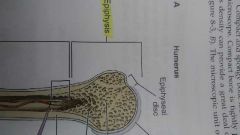
Ends of a bone |
|
|
Diaphysis |
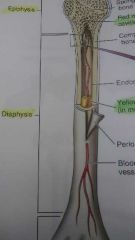
Middle of a bone |
|
|
Two types of bone |
Compact & spongy |
|
|
Compact bones |
Dense hard bones found in shafts of long bones.( yellow marrow) |
|
|
Spongy bones |
Is located primarily at the ends of long bones(red marrow) |
|
|
Atlas |

First vertebrea |
|
|
Axis |
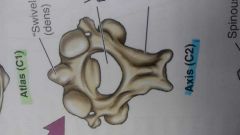
Second verterbrea |
|
|
True ribs |
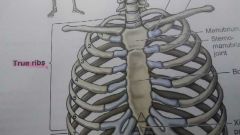
Connect to the sternum |
|
|
False ribs |
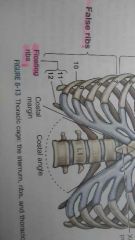
Connect to the sternum through cartilage |
|
|
Floating ribs |
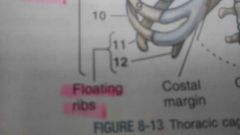
Free floating ribs |
|
|
Acromion process |

|
|
|
Coxal bone is made up by |
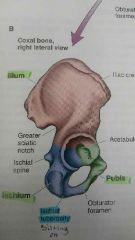
Ilium, pubis, ischium |
|
|
Ischial tuberosity |
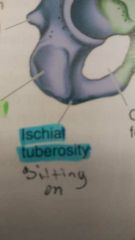
We sit on it |
|
|
Synarthrosis |
Immovable joints. The sutures on a skull. |
|
|
Amphiarthrosis |
Slightly movable joints.intervertebral disk |
|
|
Diarthrosis |
Freely movable joints. Synovial joints. |

